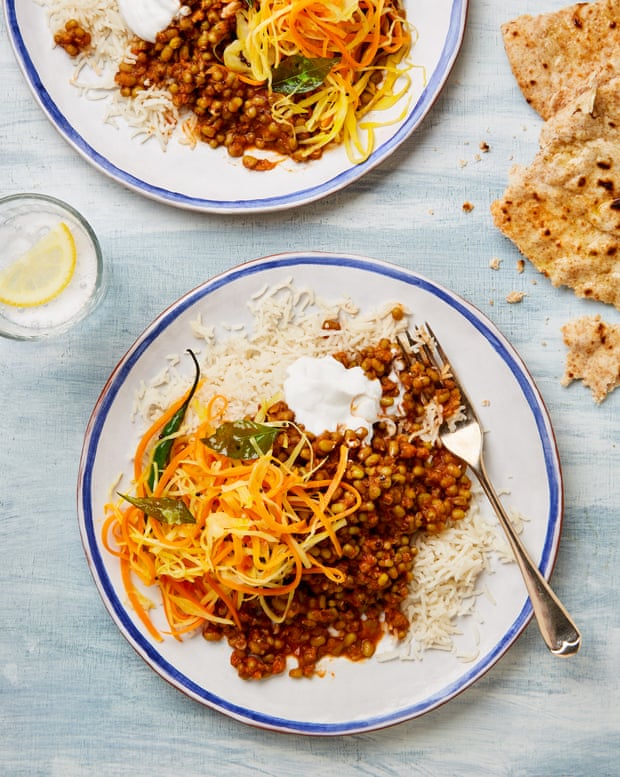A wholesome mung bean dal set off nicely by a sweet-sour cabbage and carrot relish
Mung beans are considered very lucky to the average Gujarati. These are the beans that their bones are built of, and not just because of their general prevalence. Mostly, they’re eaten wet like a dal, as in today’s dish, though sometimes they are dry-fried or sprouted with lots of garlic, cumin and lemon. Uncooked, they’re a popular bean at religious ceremonies – I still have a pocketful that were blessed at my wedding, as well as some from when I moved into my new house. Today, they are just here as an idea for dinner, but I wish you good luck in cooking them.

Gujarati whole mung dal with sambharo
Traditionally, this is made without onions or garlic, making it a simpler and gentler dal, but it does need a perky sidekick, hence the sambharo, a sweet-and-sour relish, alongside. At home, Mum would serve this with wholemeal chapatis, but I eat it with steamed jasmine rice, which I make once I’ve set the dal on to simmer. This might look like a lot of ingredients, but they all go into the pan in quick succession and many from the dal overlap with those in the sambharo.
Prep 10 min
Cook 1 hr
Serves 4
For the dal
2 tbsp rapeseed oil
½ tsp cumin seeds
1 tsp black mustard seeds
400g passata, or crushed tinned tomatoes
3cm piece fresh ginger (20g), peeled and finely grated
1 finger chilli, finely chopped
1 tsp ground coriander
1 tsp ground cumin
1¼ tsp fine sea salt
350g whole mung beans
For the sambharo
2 tbsp rapeseed oil
1 tsp black mustard seeds
2 finger chillies, slit lengthways
6 fresh curry leaves
¼ white cabbage (200g), finely shredded
1 large carrot (200g), shredded with a julienne peeler or grated
¾ tsp fine sea salt
1½ tsp lemon juice
¼ tsp sugar (or to taste)
Heat the oil in a deep saucepan over a medium heat and, when hot, add the cumin and mustard seeds, and leave to pop for 20-30 seconds. Turn the heat right down and gently add the tomatoes to the pan – watch out, because the oil might spit. Crank the heat back up to medium, then cook, stirring, for five minutes, until the tomatoes bubble thickly. Stir in the ginger, chilli, ground coriander, cumin and salt, cook for two minutes more, then add the mung beans and 1.2 litres water. Bring to a boil, then turn down to a whisper and cook, stirring every now and then, for 45 minutes, until the beans are soft but not mushy.
While the dal is cooking, make the sambharo, which can happily sit around and be eaten at room temperature. Heat the oil in a frying pan and, when hot, add the mustard seeds, chillies and curry leaves, and let them crackle and pop for 30 seconds. Add the cabbage and carrot, stir-fry for five minutes, until the vegetables have wilted but still have some crunch, then add the salt, lemon juice and sugar. Taste and adjust the seasoning accordingly.
Serve the dal over rice or alongside chapatis with the sambharo and perhaps some non-dairy yoghurt on the side.
No comments:
Post a Comment